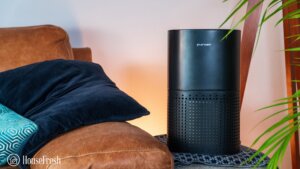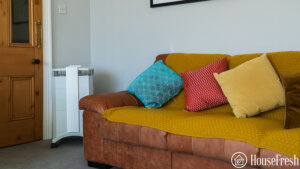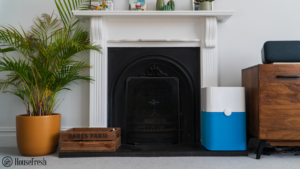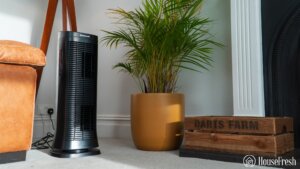Founded in Sweden by Bengt Rittri, Blueair has been around for over 20 years. Rittri wanted his children to breathe the same clean Stockholm Archipelago air while they spent time in the city. Thus, faithful to this vision, he started the company, creating simple and efficient air purifiers inspired by nature.
Back in 2016, Blueair became a Unilever brand. According to Rittri, the global company would help expand Bluair’s capability to reach more people in need of simple and affordable solutions for air pollution. The brand obtained a B Corp certification in 2023 with a clear mission of improving air quality in homes, schools and offices worldwide, focusing on children’s right to clean air.
I love the social and environmental commitment of the brand, as well as Rittri’s belief that freedom to breathe is a basic right. But we’re not here for the charms and chimes of brand positioning and marketing.
When it comes to cleaning power, Blueair mixes simplicity with efficiency and offers an array of models for different space sizes. All units, however, feature the trademark HEPASilent™ Technology that combines electrostatic and mechanical filtration. I’m not a big fan of ionization, but we’ll get into that later.
As for the Blue Pure 411, it’s better suited for small rooms. It’s worth noting, though, that since Blueair became part of the Unilever family, its product range has broadly expanded. The launching of the Pure Max line in 2023 replaced some of the older models, including the Blue Pure 411.
With such a prolific portfolio, navigating models can be a bit confusing, especially regarding filter replacements. Blue Pure 411, 411 Auto, and 411+ are three separate models but share the same filter; the 411a Max and 411i Max, on the other hand, use different ones. In a core comparison, however, they are not that far apart: the CADR rating, filter mechanism and Blueair’s HEPASilent™ Technology are scarcely different when not the same.
- In our home lab of 728 cubic feet, we light an incense stick to generate particle pollution and VOCs.
- We set up our trusted Purpleair Indoor Sensor with the latest Bosch gas sensor to track levels of PM1ug/m3, PM2.5ug/m3 and PM10ug/m3 and VOCs in the air.

- We switch the air purifier to its highest speed and measure how long it takes to get our room air quality down to PM1 level to 0.
- We use an energy meter to measure precisely how much electricity is used when running the unit at the lowest and highest fan speed settings.
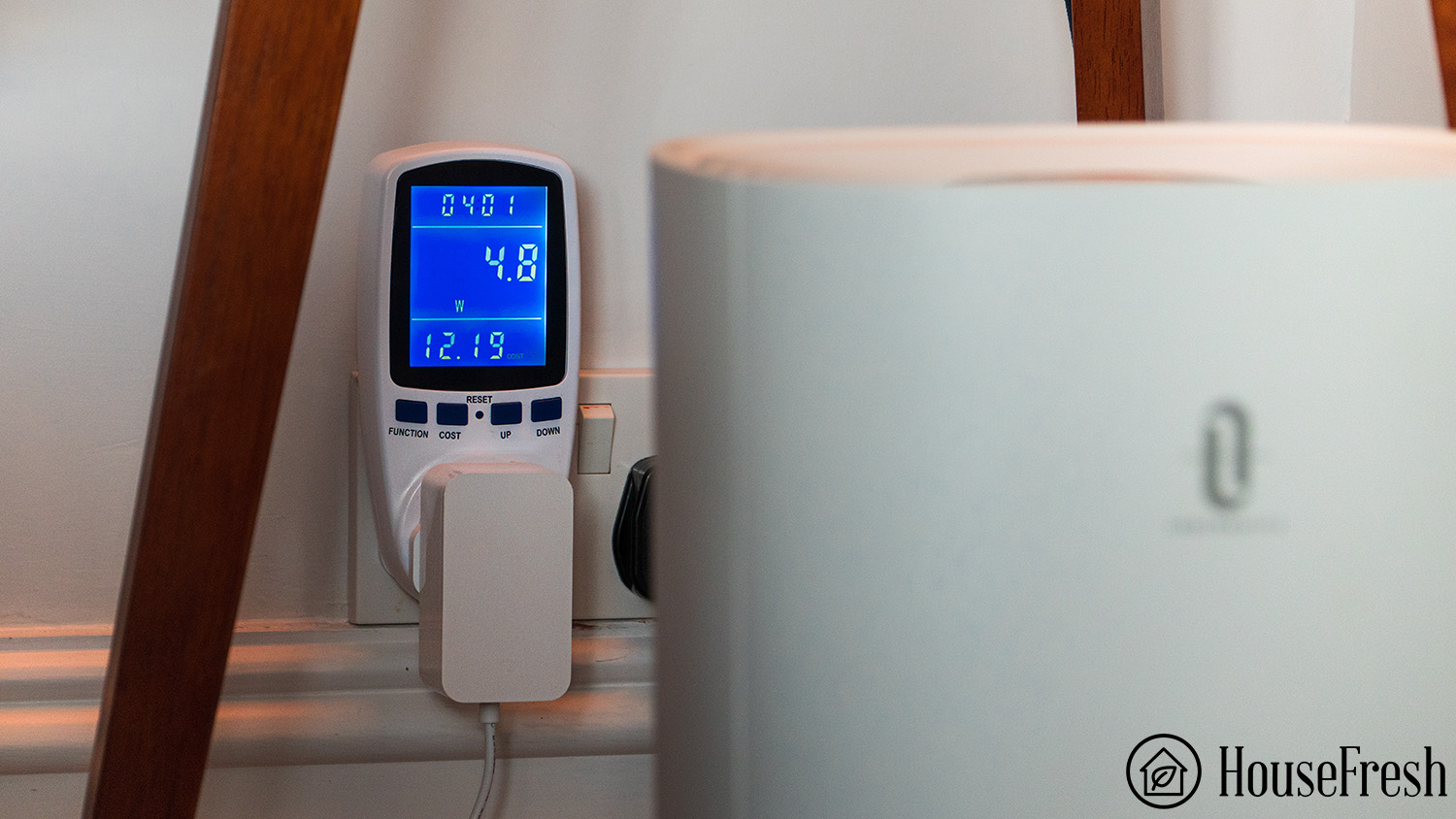
- We track sound levels emitted by the air purifier at different fan speeds with the help of a commercial sound meter.

But if you’re here, you probably want to know more about the Pure 411 and its performance. So, let’s get to it.
The lowdown on the Blueair Pure 411
Innovative concept but has no outstanding cleaning power.


We’ll delve into a detailed analysis of the Blue Pure 411, covering design, performance and noise output, among other things. But if you want to know black over white, our take on the pros and cons of the unit, check out the chart below:
What we really like
What we think could be better
The specs
The range of small air purifiers was much more limited when the Blueair Blue Puro 411 was launched. It wasn’t the most budget-friendly air purifier back then, but its CADR was ok (120 CFM) compared to other popular small units, such as the Levoit Core 200S (118 CFM).
However, the standout point of the Puro 411 was the original design that disrupted the scene with lively colors and scandic aesthetics.
Since the newer Max Pro line became the key product Bluair focuses its communication on, the Puro 411 can now be found at $119 on Amazon — although still more expensive than the reliable Levoit Core 300 or newer and highly efficient units like the Winix A230.
| HouseFresh Rating: | ★★★☆☆ |
| Time to clean our test room: | 1 hour and 8 minutes |
| Air purifier technology: | Washable pre-filter, activated carbon filter, HEPASilent™ filter + Ionizer technology |
| Recommended room size: | 161 sq. ft. |
| Clean air delivery rate (CADR): | 120 CFM |
| Dimensions (in inches / in cm): | 16.7H x 8W x 8D inches (42H x 20W x 20D cm) |
| Weight (in pounds / in kg): | 5.3 lbs (2.4 kg) |
| Noise level (measured from 3 ft. away): | Speed 1: 36.2 dB Speed 2: 42.1 dB Speed 3: 53.1 dB |
| Filter life: | 6 months |
| Electricity consumption (kilowatt-hour): | Standby mode: 0 kWh Speed 1: 0.9 kWh Speed 2: 2.9 kWh Speed 3: 7.8 kWh Speed 4: 10 kWh |
| Estimated running costs (electricity consumption + filter replacements): | $52.28 per year |
| Manufacturer’s warranty: | 1 year |
| Country of manufacture: | Designed and engineered in Sweden, assembled in China |
Minimalistic build, playful design
A thoughtfully engineered structure with customizable looks, although somewhat on the flimsy side.

Blueair was created with children in mind. It only makes sense that the original Blue Pure line is so colorful and lively yet has straightforward controls. I opted for the Diva Blue fabric pre-filter (which brings this iconic Diva to mind), but there are six colors to choose from, ranging from buff yellow to a sober dark gray for those who prefer a more subtle approach.

The top white cylinder houses the fan and ionizer, crowned by an organic-shaped control panel. The lower body accommodates the pre-filter and main filter, which fit neatly into a plastic honeycomb structure. The rounded body allows for an efficient 360 air inlet, while the clean air is then released from the top grill.
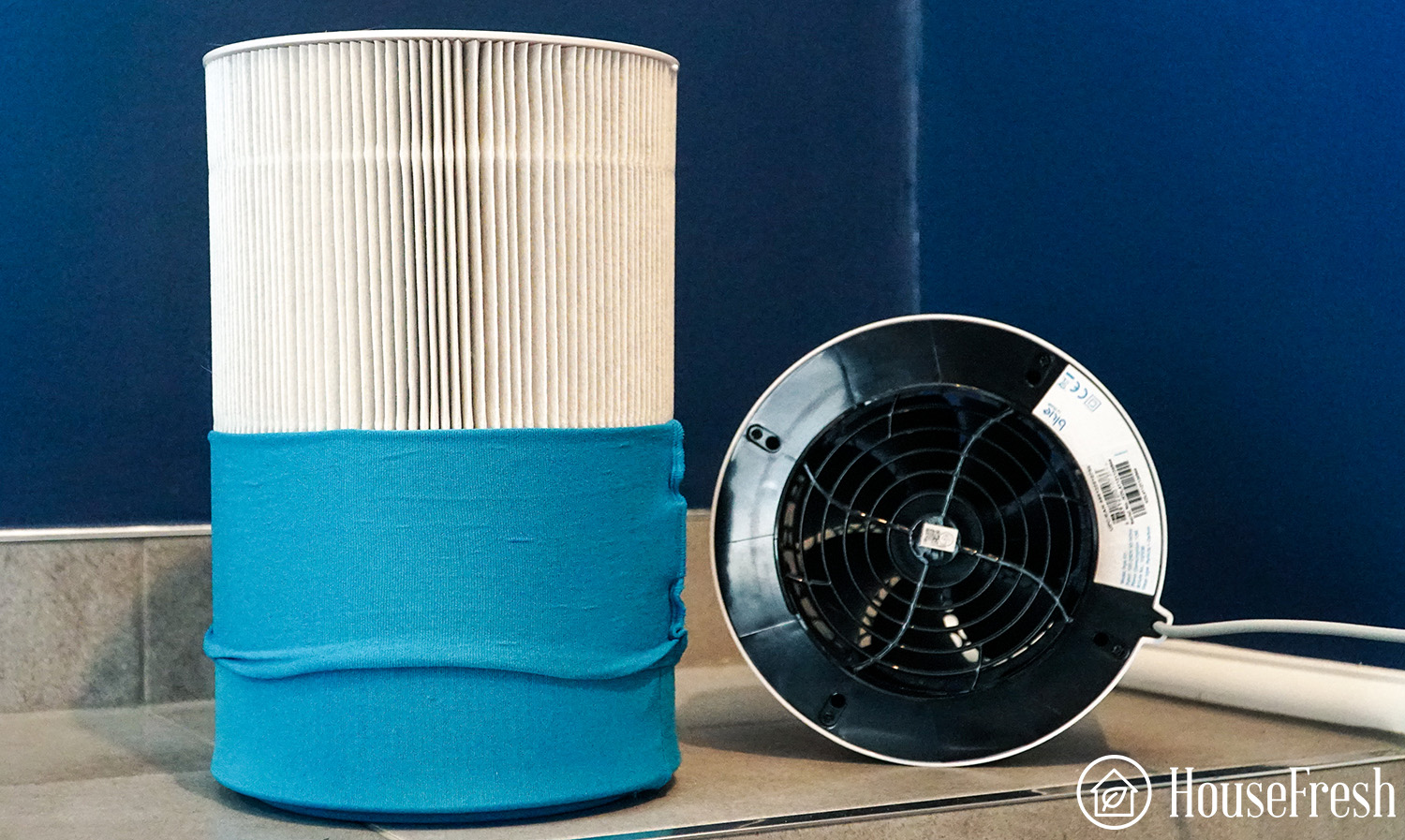
Designed for ergonomic efficiency with the minimum amount of elements, the Pure 411 is both compact and lightweight (5.3 lbs). As the smallest unit of the Blue Pure line, it will easily fit even in tiny rooms, not using up too much space, while it weighs close to nothing to move around.
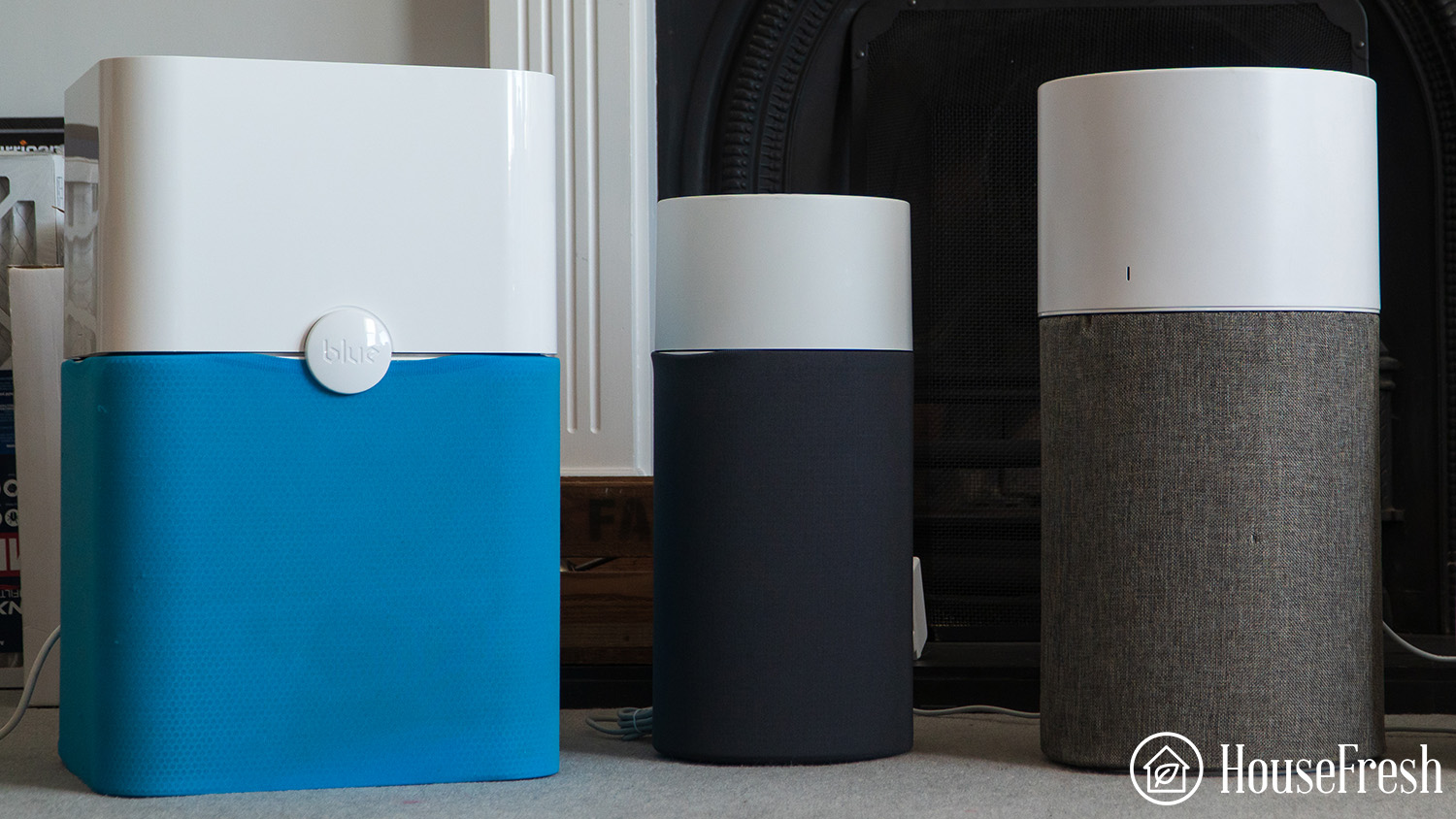
However, this also means the structure requires gentle handling as there’s no outer casing or grill to protect the filer when manipulating the unit. Besides, most of the weight is at the top cylinder, so it’s somewhat flimsy and easier to tip over.
Simplicity peaks with the control panel. There’s only one button on the Blue Pure 411 to switch on and off and cycle through three fan speeds. That’s right, even the young members of the family could operate it.
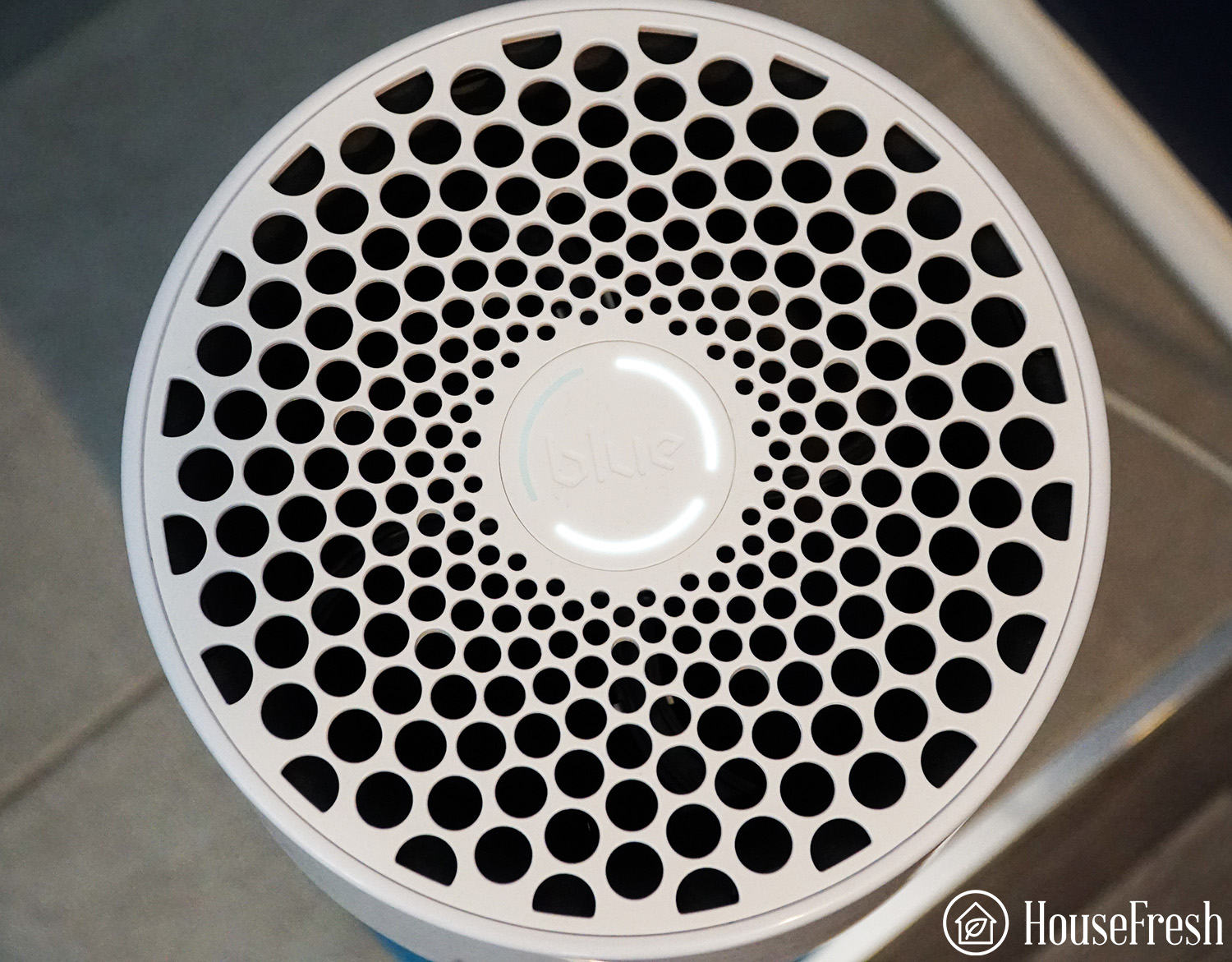
Press the big round button once to start the air purifier at the lowest speed; a second and third press will step up the unit to the following fan speeds. One last touch will switch it off. The white LED lights around the button indicating the speed it’s on will dim after seven seconds of no interaction.
This is one of those nice touches that show how thoughtful Blueair designers are, especially if you’ll be placing the unit in the bedroom. For that matter, however, it would be nice to have a no-lights function.
Although the one-button control is modest and straightforward, the Pure 411 has a built-in memory, so if you unplug the unit, the unit will remember your settings once replugged. Yet, this is the only “smart” feature, as there’s no auto mode, timer or app support.
Blueair’s trademark HEPASilent™ filtration system
What’s this technology all Blueair purifiers feature?
In short, HEPASilent™ technology is no more than a HEPA-type filter boosted by an ionizer. It’s a bit misleading, as the filter is not a real HEPA. But many brands coin creative names for their products using keywords we look out for to feel secure about our purchases. With this trademark, brand communications can use the word without the certification required for it to be real HEPA.
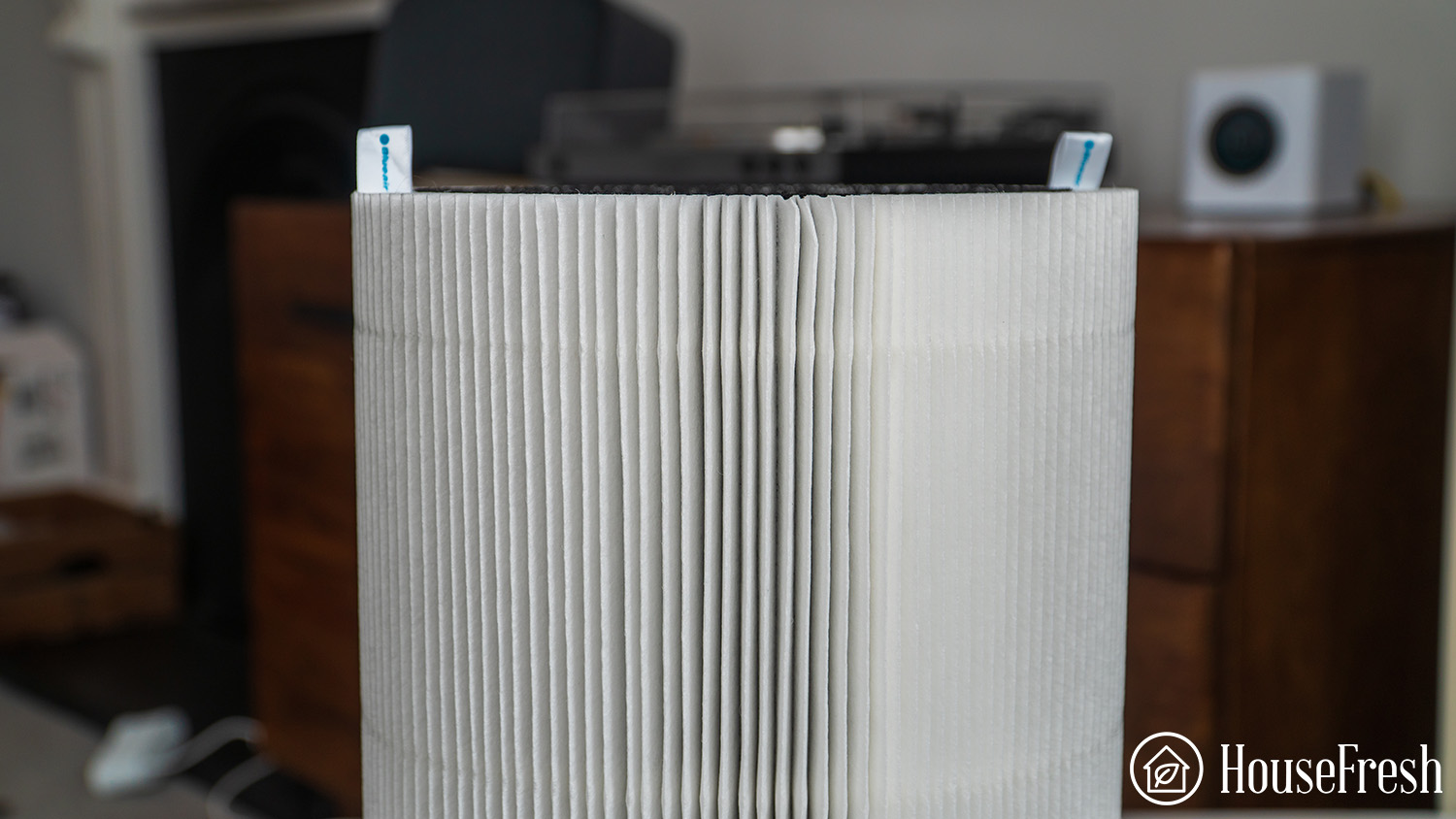
Blueair filters are less dense than HEPA. This is not all bad, as a thinner filter media requires less power to create an airflow capable of passing through it. That’s how their units can clean the air with low energy consumption and more silently —hence the HEPASilent™.
But to remove 99.97% of airborne pollutants, this type of filter is not enough. That’s why Blueair combines mechanical (HEPA-type) with electrostatic filtration. An ionizer within the fan’s hood produces an electrostatic discharge, releasing ions that attach to airborne pollutants making them stickier and heavier, thus easier for the unit to capture and filter.
The downside of this technology is that it produces ozone as a byproduct. According to Blueair’s website:
All Blueair air purifiers are CARB certified which means that they are considered safe and do not exceed ozone emission limits.
Not exceeding ozone emission limits isn’t the same as not producing ozone at all. And then, even a slight amount of ozone can react with common gasses found in every home (including fumes from cleaning products) and produce further VOCs such as formaldehyde.
However this type of combination device is unlikely to introduce any ozone as the particle and carbon filters will help to remove the ozone from the ionizer before it leaves the device. The larger 211 of the Blue Pure series has a certificate showing that it produces zero ozone emissions —check the certificate at Intertek— so we can assume the same with this smaller device in the series.
Sadly, the ionizer cannot be switched off on Blueair purifiers. Both technologies are engineered to work together, unlike other units that have an ionizer as a plus (such as the Winix Plasmawave).

The filters also feature an activated carbon layer, although it’s an impregnated fabric instead of granular or pelleted charcoal.
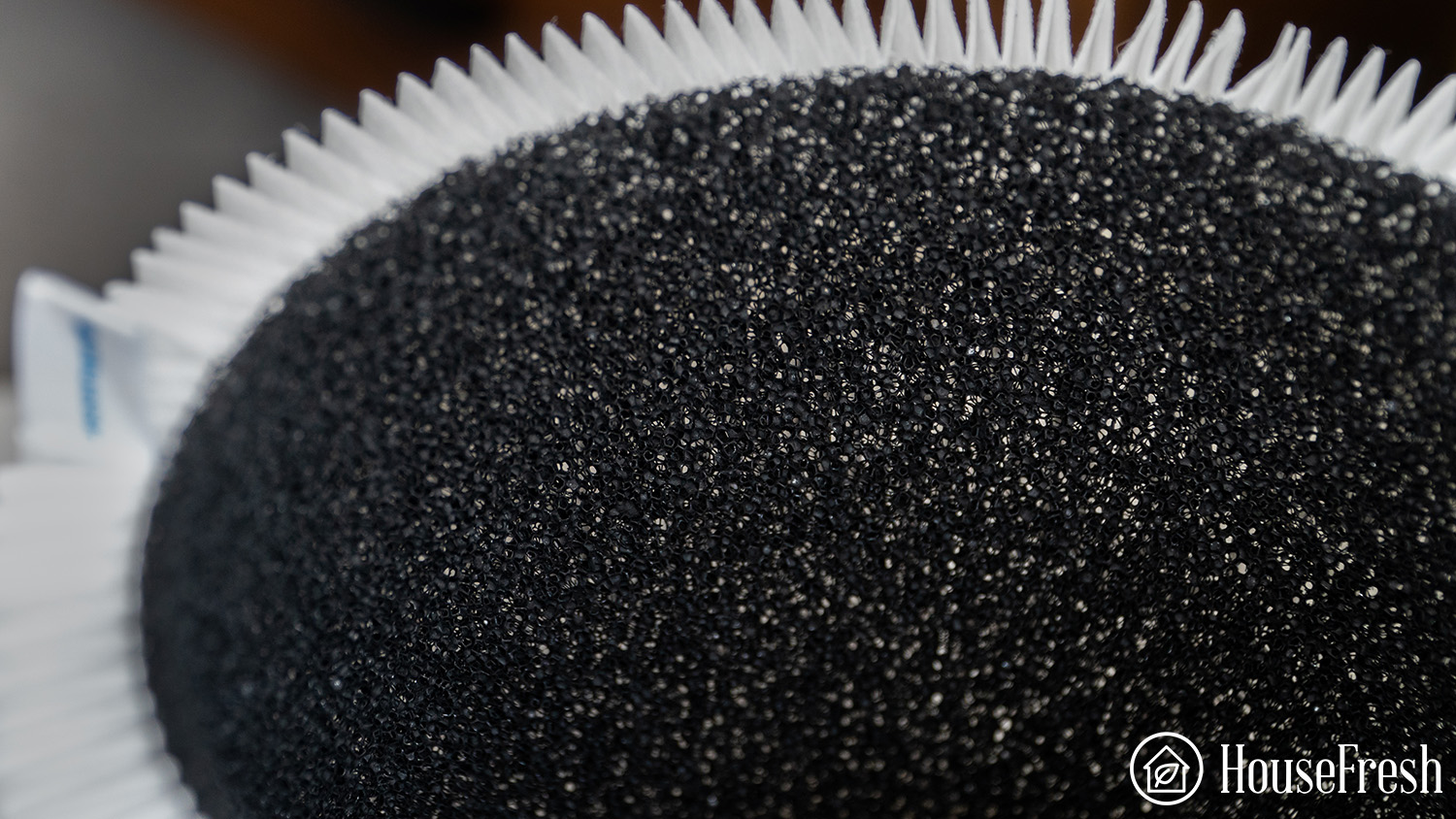
This media is not robust enough to deal with serious odor or VOC issues, but it will help with mild everyday smells.
Lastly, there’s the outer pre-filter that traps bigger particles such as lint, dust and pet fur before they reach the mail filter. Washable prefilters are a functional upgrade as they can be thrown into the washing machine or vacuumed easily. Blueair recommends cleaning the pre-filter every three months to extend the lifespan of the main filter.
Now, the steps to change the Blue Pure 411 filter are somewhat different compared to other more traditional air purifiers. But the process is still pretty straightforward.
After six months of continuous use, the LED lights on the one-button control will turn red, indicating it’s time for a filter replacement. After unplugging the unit, unscrew the top cap with a gentle twist. Remove the fabric pre-filter and pull out the main filter using the tabs on the sides. Place the new filter on the plastic structure, then the pre-filter and finally, replace the cap.
Like with most air purifiers, Blueair filters come sealed in a plastic bag to protect them until it’s time they get to work. When unboxing your new Blue Pure 411, make sure to remove any packaging from the inside of the unit before running it. The same applies to filter replacements. Otherwise, the unit won’t be able to operate properly.
The Blueair Blue Pure 411 cleared our test room in 68 minutes
Silent and easy to look at, but far from being the fastest.
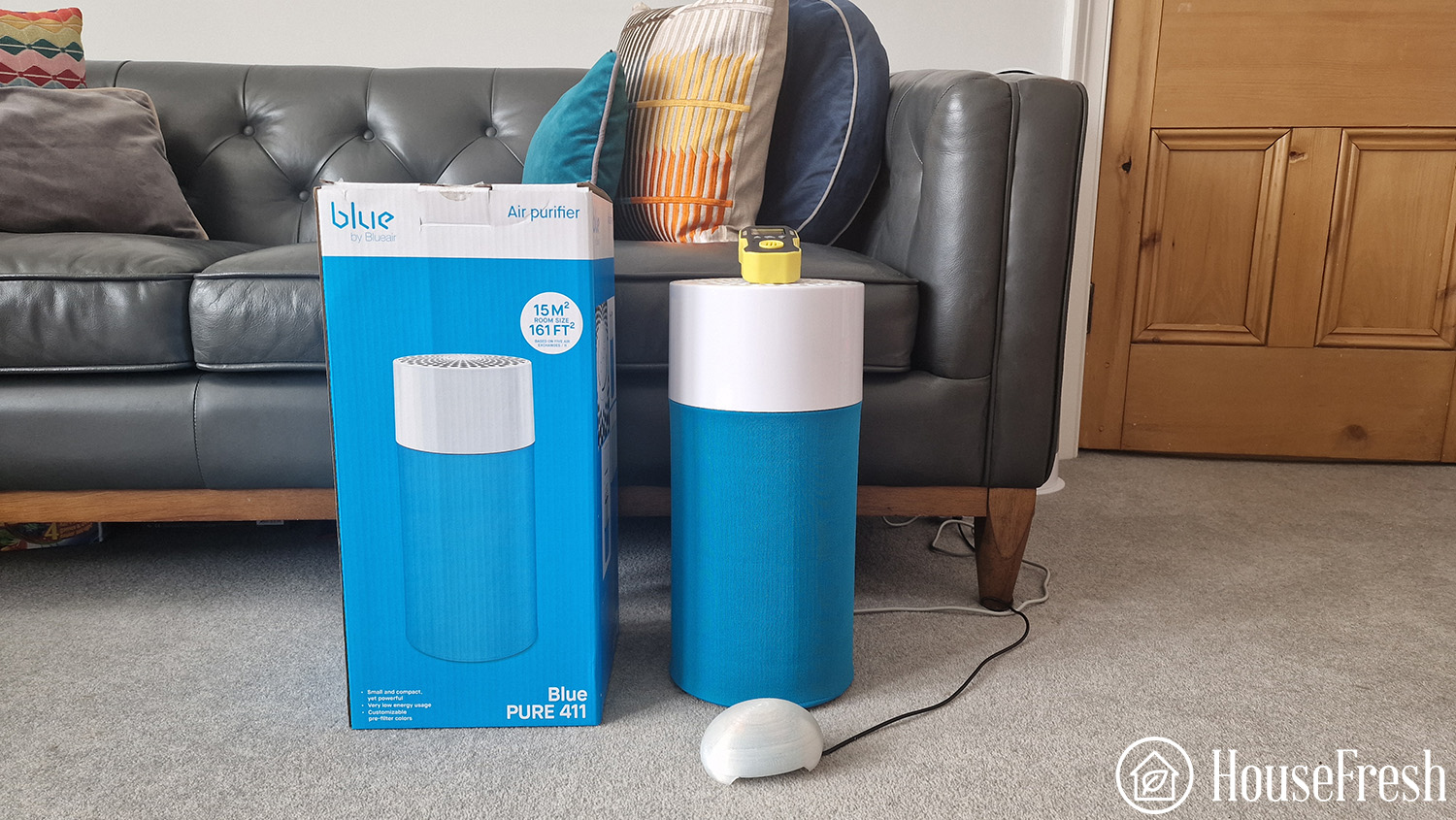
We often find that brands claim (and big publishing companies spread all over the internet) far more than their products actually deliver. That’s why, at HouseFresh, we like to take things into our own hands.
We conduct our performance tests in our 728 cubic ft. home laboratory. What does the HouseFresh testing process involve? We first generate pollutants by burning incense sticks. The PurpleAir Touch Indoor Air Quality Monitor —one of the most accurate sensors in the market— then helps us track how fast (or slow) each unit removes the PM1, PM2.5 and PM10 produced by the incense smoke.
As all of our tests are conducted in the same space, we can easily compare results across units.
Now, without further ado, let’s get a look at the data:
Air cleaning performance, compared
Cleaning speed is a good indicator to asses an air purifier’s performance. Knowing the Blue Pure 411 took 68 minutes already gives us an idea of its efficiency. But it’s usually not as graphic as comparing it with other units.
Let’s start by saying the Blue Pure 411 is an air purifier designed for small rooms. According to the Energy Star testing, it can achieve five air changes per hour in spaces of 163 sq. ft, with a CADR rating of 120 CFM.
It’s only fair, then, to compare its performance with other small air purifiers. The most straightforward comparison is with its upgraded version, the Blue Pure 411+ (which is not the 411 Auto nor the 411 Max models). The 411+ is not only 25 minutes faster, but it also comes with smart features and app support.
The Levoit Core 200S is another similar unit that, with a lower CADR (118 CFM) and for less money, cleaned our lab nine minutes faster than the Blue Pure 411. Besides, Levoit units only use mechanical filtration.
It’s not all bad news, though. There are slower air purifiers on the market, such as the Molekule Air Mini or the $700 Dyson PH03. In truth, neither of these are air purifiers we recommend. But, then, speed is not the only determining factor in choosing an air purifier. Other aspects of the Blue Pure 411 make it a suitable option for small rooms— take the noise output, for example.
Noise levels test results, compared
Using a commercial sound meter, we registered the decibels (dB) emitted by the Blue Pure 411 at every fan speed from three ft. away.
The HEPASilent ™ technology is indeed quiet, at least to a certain extent: at its lowest fan speed, the noise output was 17 dB — which is barely hearable. In fact, you need to be really close to the unit to hear its hum.
But then, at top speed, there’s a noticeable change. The dB rises to 56.2 dB at its fastest. For reference, 50 dB sounds like a quiet office.
With these results, I can only say the Blue Pure 411 delivers the Silent promise to a limited extent. Yes, the 17 dB are far above the average in the table comparison. But then, we should factor in the fan’s power at each speed.
As you can see, the airflow changes drastically among speeds. It can be quiet at the lowest, alright, but the cleaning power is significantly reduced. With that fan power, the small Blue Pure 411 would make little changes to your air.
Besides, the AHAM CADR testing is always done at an air purifier’s highest speed, meaning that the unit should be running at top speed to achieve the 120 CFM and five air changes per hour in a small room.
But decibels are a rather abstract measurement. And perception of sound varies from person to person. That’s why we’ve recorded the unit’s noise output. Hear the Blue Pure 411 in action for yourself.
The cost to run a Blueair Blue Pure 411: $52.28 per year
An outstandingly energy-efficient unit with affordable replacement filters.
1. Electricity costs = $10.5 per year
The initial purchase price is only one variable to determine if an air purifier is a good investment. Then there’s the fixed costs you’ll be facing in the long run, including energy consumption and filter replacements.
In terms of electricity costs, Blueair’s HEPASilent™ technology is remarkably efficient. The Blue Pure 411 is no exception: it made the 2024 Energy Star Most Efficient list, which features the year’s most energy-conscious appliances. For a somewhat old model, this is saying a lot.
Breaking it down by numbers, the 411’s power consumption ranges from 1.5 W to 10 W at the lowest and fastest speeds, respectively. This means that if you were to use the unit all year round, 24/7, at top speed, the cost would be less than $1 a month. To put it into perspective, an average LED light bulb uses about 10 watts. Not bad at all.
2. Filter costs = $41.78 per year
In addition to energy usage, it’s important to factor in the filter costs. Eventually, all HEPA (and HEPA-type) filters need replacement. The airborne pollutants trapped by the air purifier accumulate on the filter’s surface — which, in the long run, becomes clogged with those same filtered particles.
Now, the frequency of filter replacement depends on how much you use the unit and the level of air pollution in your area. But as a general rule, Blueair recommends changing the Pure 411 filters every six months. This brings us to two filters per year, summing up to $41.78 if you buy the original ones.
When compared to similar units, Blueair’s filters are reasonably priced. The Levoit Core 200S and 300S filters, for example, cost between $25 and $30, slightly varying on the unit. Then, the Winix A230 replacement filters can be found at $49.99, although you need to replace these only once a year.
- COMPATIBLE WITH ENTIRE BLUE PURE 411 AIR PURIFIER LINE: Blueair Combination Particle plus Carbon Replacement Filter compatible with entire Blue Pure 411 air purifier line consisting of Blue Pure 411 Auto, Blue Pure 411, Blue Pure 411 plus air purifiers
- FILTERS BUILT TO LAST: Using a 360-degree air intake and up to 4x the filter surface area the Genuine Blue Pure 411 Particle and Activated Carbon Filter lasts on average 6 months to a year; optimizing air flow and performance over time
Besides, as the Blue Pure 411 has been around for quite a long time, there are plenty of generic, cheaper options available. Although we’ve only tested the unit with genuine Blueair filters, so we cannot vouch for their performance.
- Compatible : Premium PARTICLE and ACTIVATED CARBON filter Fits the Blue Pure 411, 411+ and Mini Air Purifier.Get back to having a clean air to breathe again!
- Particle Filters :PARTICLE filters can remove large and airborne particles, including dust, pet dander, common pollutants, and fabric fibers.
Bottom line
There’s a playfulness about the Blue Pure 411 that makes it unique.
The simple one-button control adds the perfect touch to that lively flair I miss in the new Blueair Max line. The brand has taken a more sober turn on the latest designs, aligning with current trends that demand desaturated colors and textures. But I kind of miss the old cheerfulness.
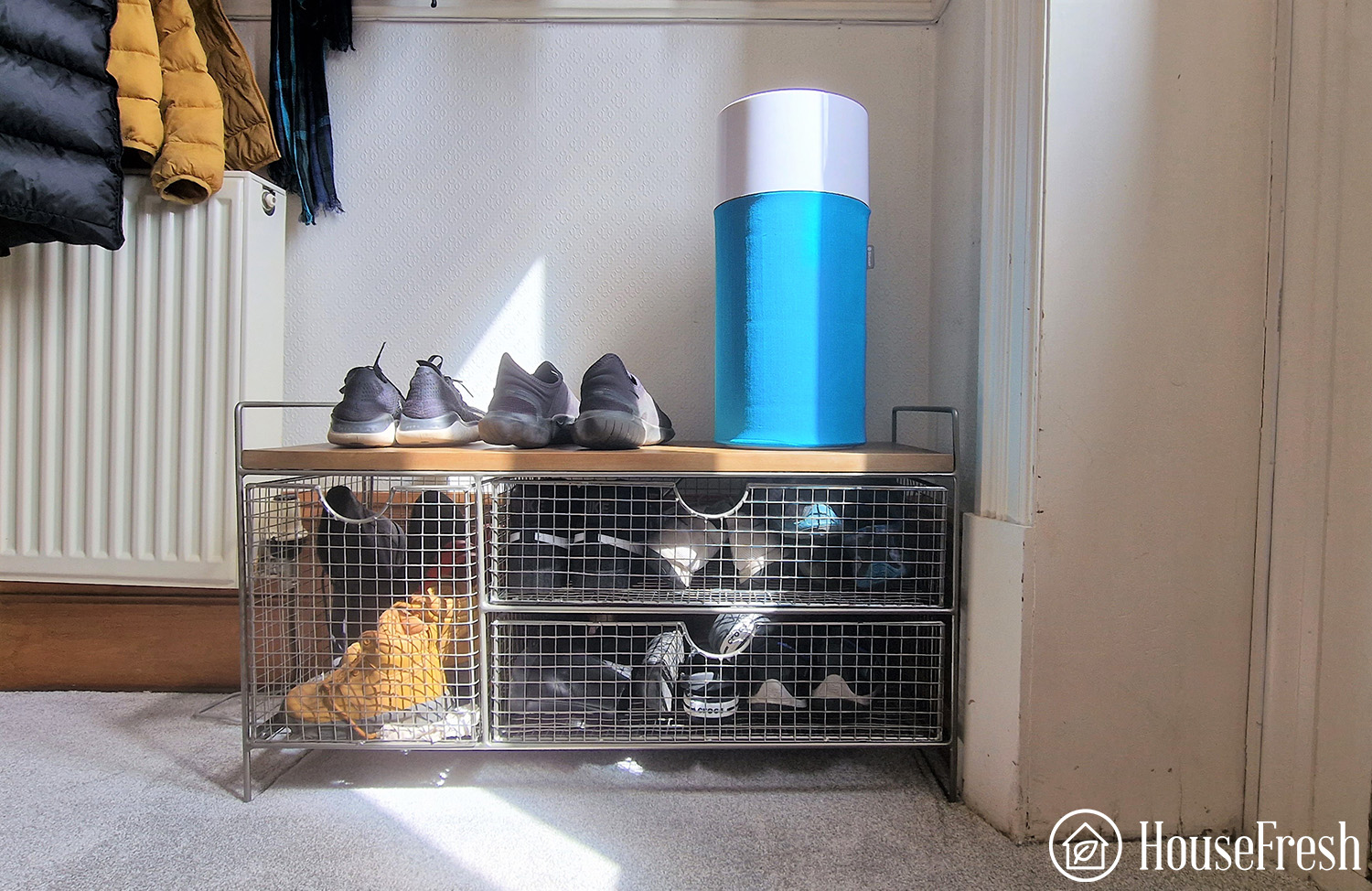
In terms of performance and functionality, the Blue Pure 411 is compact, has low running costs and operates reasonably well. All these features make it a good choice for small rooms like bedrooms.
However, if you prefer pure mechanical filtration, then the Levoit Core 300 (or 300S if you would like to upgrade to a smart unit) is one reliable unit I know I can trust. Then, if you are looking for an air purifier for bigger rooms, I’d take a look at the Levoit Vital 200S, which can achieve five air changes per hour in 375 sq. ft. in 21 minutes.
SOURCES
We calculated the monthly energy consumption costs with the help of the Department of Energy’s appliance energy calculator. We calculated yearly costs associated with running the Blueair Blue Pure 411 24 hours a day for 365 days. We chose to run this calculation utilizing the U.S. average utility rate, which is $10.51/kWh as of March 7th, 2024.
Last update on 2024-04-19 / Affiliate links / Images from Amazon Product Advertising API


